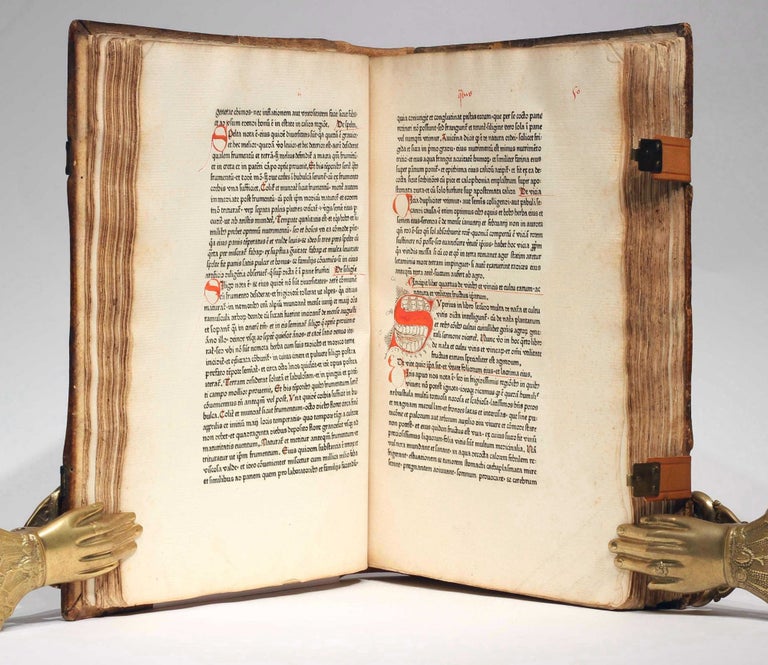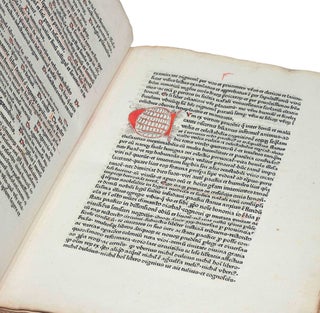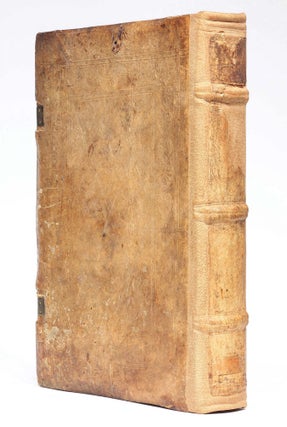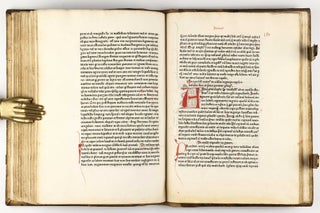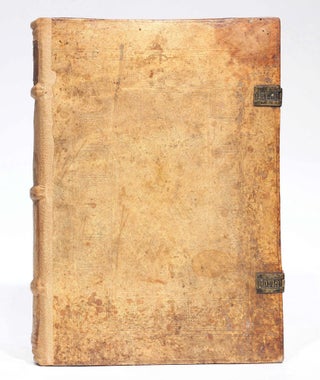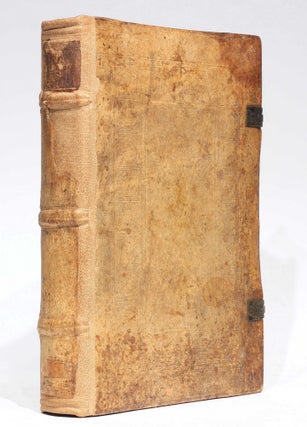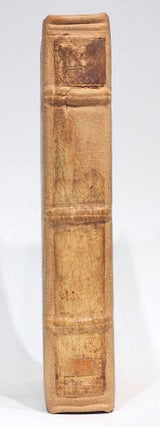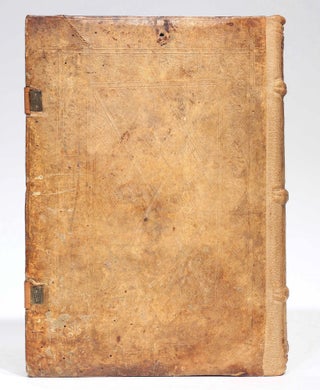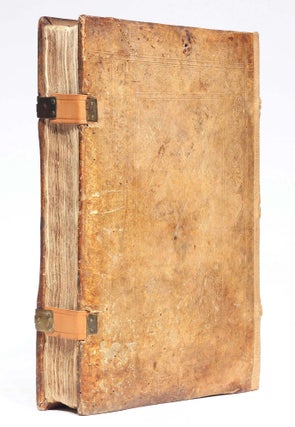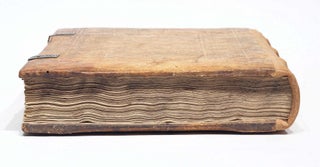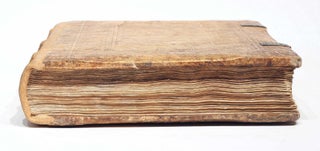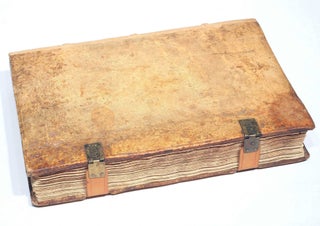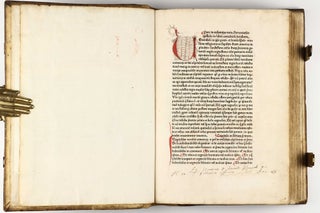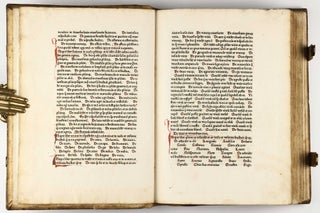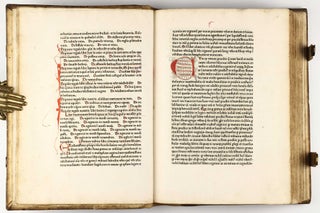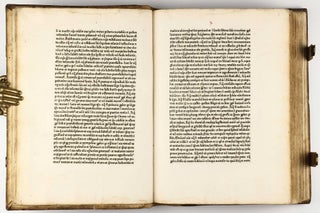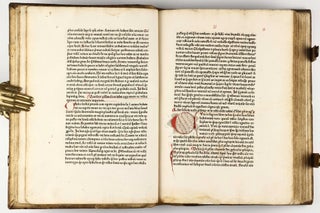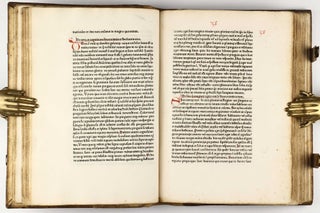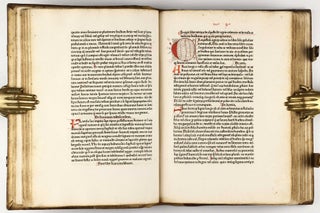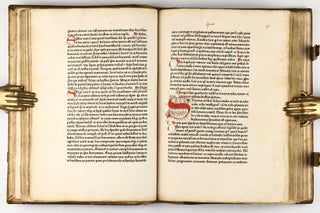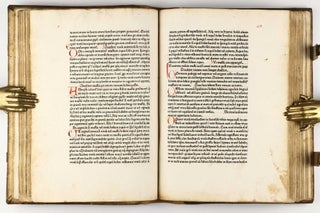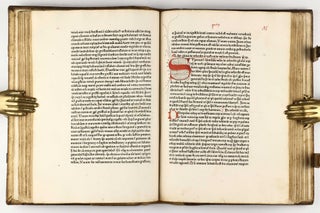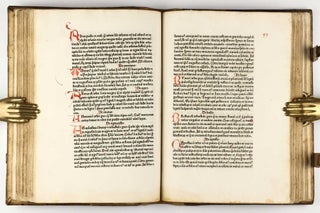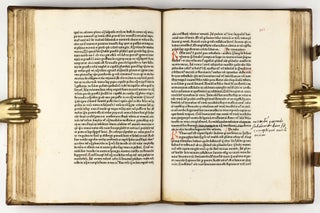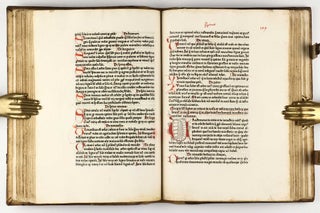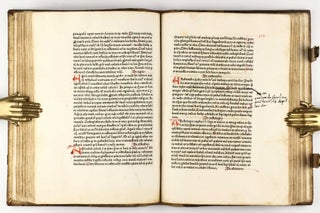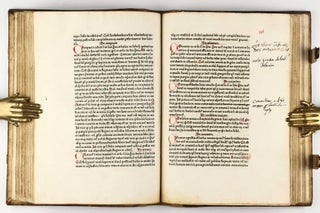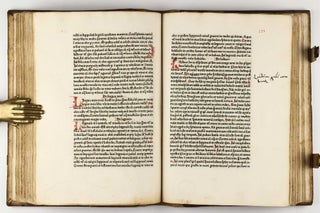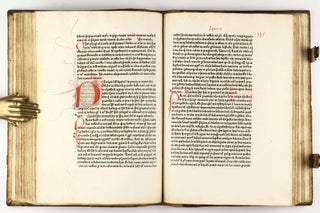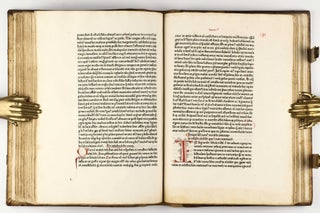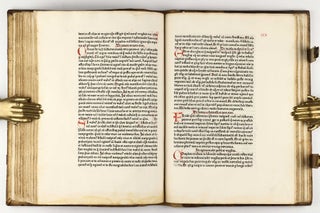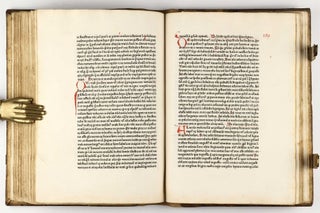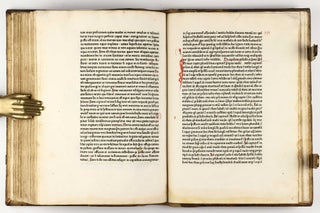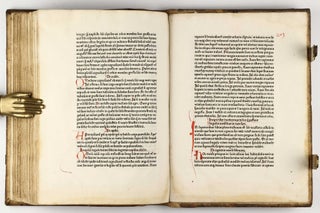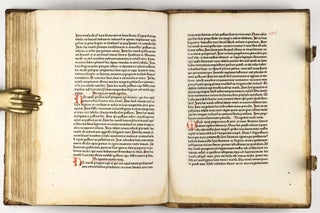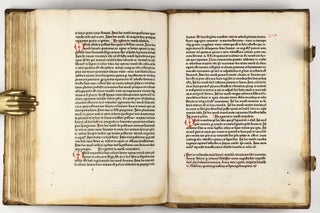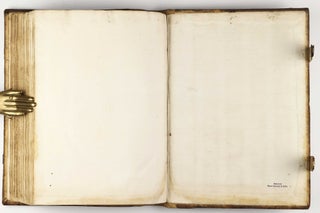Editio princeps of the most important agricultural treatise of the middle ages
Ruralia commoda.
Augsburg: Johann Schüssler, 1471.
1st Edition. Hardcover. Very Good. Item #003247
16 February 1471. Chancery folio (296 x 215 mm). 209 leaves (of 212, without the final 3 blanks). Collation: [a-s10 t12 v10 x7]. 35 lines, gothic type 1:117G. Title in incipit (leaf [a]1r): Petri de crescentiis civis. Bononiensis epistola in libru[m] co[m]modoru[m] ruralium. Illuminated throughout including one 8-line and eight 6-line initials painted in red and with dark-brown penwork, two of them with penwork extensions, several red-painted 2-line initials, red manuscript page numbers, red paragraphs, initial strokes and underlining, all in contemporary hand and typical for illumination by the Schüssler workshop. Original, gothic, elaborately blind-ruled and blind-stamped Augsburg binding of pressed pigskin over wooden boards, spine with 3 raised bands, two original brass catches and one original clasp present, one clasp and the leather straps renewed, upper edge of lower board with traces of old chain attachment, original endpapers preserved (binding expertly restored in the 1960s by Hans Heiland & Sohn with the original board material and most of the spine leather preserved; soiling, browning and spotting of the leather). Text leaves unpressed and untrimmed preserving the deckle edges. Internally very little browned, light dust-soiling and browning of outer edges, occasional mostly marginal spotting and finger-soiling, two small wormholes in blank lower corner of gatherings [v] to [x], faint dampstaining to lower blank margin of a few gatherings towards end, but all in all exceptionally crisp and clean. Provenance: Leonard Kempet (contemporary, partly erased donation notice "Ex donatione v. Leonardi Kempet pro Bibliotheca Officio xxx, anno 1611") at bottom margin of first page; Karl & Faber, Munich, Auction 59, 1957, lot 47 (original lot description loosely inserted), a few annotations and text markings in contemporary black ink, small ink stamp by Heiland & Sohn on rear pastedown. An outstanding, completely untrimmed and crisp copy in its original gothic Augsburg Fuchsvogel/Schüssler binding. ----
EDITIO PRINCEPS of the most important medieval agricultural treatise and, apart from the Bartholomaeus Anglicus' De proprietatibus rerum, the earliest non-classical work to deal with agriculture and viticulture. The author, a successful Bolognese advocate, had retired to his estate in 1299, where he was working on his agricultural handbook, which he finished in 1305. A total of 91 preserved Latin manuscripts of Crescentiis' Ruralia commoda prove the broad tradition of the work in medieval times. The work has early been translated into German and other vernaculars. After Schüssler's first print, there were nine Latin and three German editions until 1500 alone.
A student of Günther Zainer in Augsburg, Schüssler opened his own printing press (the second in Augsburg) in 1470 and took over a discharged typeset from Zainer. Within almost 4 years until his death in 1473/4 Schüssler finished the printing of 12 mostly theological and historical works in Latin, but also Crescentiis' late-medieval work on rural economy, his second printing, for which he used a manuscript held by the Benedictine convent St. Ulrich and Afra. The connection between Schüssler and the convent must have been close, because in 1472 the Abbot of the convent Melchior von Stammheim acquired Schüssler's workshop and invested in new equipment. Melchior is said to have also been involved in the appointment of Zainer to Augsburg, but at least the new way of producing books was so dear to his heart that the idea of setting up a printing press in the monastery did not allow him to rest. (see G. Hägele, p.36).
Our copy has survived in its original gothic binding, which is all but common, as important and very valuable books such as this often received elaborate and costly but rather modern recasements in the preferred style of its owner. The binding was made in the workshop of the Wundervogel or Fuchsvogel-Meister I (EBDB w001512/Kyriss No. 90), which was active in Augsburg from 1468 to 1476 (see Wagner-Reed, p.211). The bindery is identified by the used characteristic single stamps, Basilisk (Schwenke-Schunke 18), Palmette (Schwenke-Schunke 39=43), Rosette and Doppellilie (Schwenke-Schunke 356). A further indication is the handmade brass closures, characteristic for this workshop. Another copy of the Ruralia commoda in a binding of this workshop is kept in the Staats- und Stadbibliothek Augsburg (Ink 283) and had previously been in the convent of the Augsburg Jesuits. Moreover, our binding is very similar to that of the Ruralia commoda in the Pierpont Morgan Library (PML 18736) from the same workshop (see, The Scott Husby Database at Princeton University Library, ID 185382). The more frequent occurrence of these and other Schüssler prints in a binding of workshop Kyriss 90 leads to the assumption that Schüssler himself ordered the binding of at least a portion of his print runs there and sold these with a price premium, preferably to his local clients.
All surviving copies of the editio princeps that have come to market are rare and highly priced. The Marcel Jeanson copy sold at Sotheby's in 2017 (lot 55, sales price GBP 187,500) is almost certainly in a contemporary but remboitage binding; the Rothamsted Library copy acquired and sold by Jonathan Hill bookseller in 2018 (his catalogue 228, USD 225,000) is in a 19th century binding. We can trace only one copy in strictly contemporary (sheepskin) binding: the Andre Simon-Crahan-Keck Day copy, sold 1986 at Sothebys (lot 140, USD 27,500).
Literature: Goff C965; HC 5828; BMC ii 328; BSB-Ink C-695; Bod-inc C-477; GW 7820; Klebs 310.1; Fairfax Murray, German 126; Simon BG 401. Kyriss, Verzierte gotische Einbände im alten deutschen Sprachgebiet, Stuttgart, Hettler 1951-1958; B. Wagner & M. Reed (eds.), Early Printed Books as Material Objects: Proceedings of the Conference Organized by the IFLA Rare Books and Manuscripts Section, Munich, 19-21 August 2009, De Gruyter Saur, 2010); I. Schunke, Die Schwenke-Sammlung gotischer Stempel- und Einbanddurchreibungen nach Motiven geordnet und nach Werkstätten bestimmt und beschrieben, vol. l: Einzelstempel, Beiträge zur Inkunabelkunde III,7 (Berlin, Akademie-Verlag, 1979), cited as Schwenke-Schunke; A. Roeding, Studier till Petrus de Crescentiis... Diss. Göteborg 1927; A. Sorbelli, Bibliografia delle edizioni dell'opera di Pier de' Crescenzi [in Pier de' Crescenzi. Studi e documenti] Bologna 1933; A. Taurino, I 'Libri Commodorum Ruralium' di Pietro de Crescenzi, bolognese (1233–1321). Edizioni a stampa e manoscritti. In: Manoscritti, editoria e biblioteche dal medioevo all’ età contemporanea. Studi offerti a Domenico Maffei per il suo ottantesimo compleanno. Editors, Mario Ascheri & Gaetano Colli., Vol. 3., Rome 2006, pp. 1281–1309.
. . . Visit our website to see more images!
Sold
Delivery time up to 10 days. For calculation of the latest delivery date, follow the link: Delivery times
Lieferzeit max. 10 Tage. Zur Berechnung des spätesten Liefertermins siehe hier: Lieferzeiten


